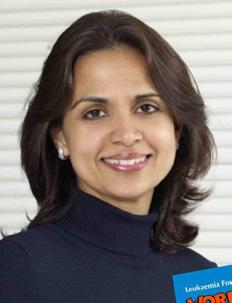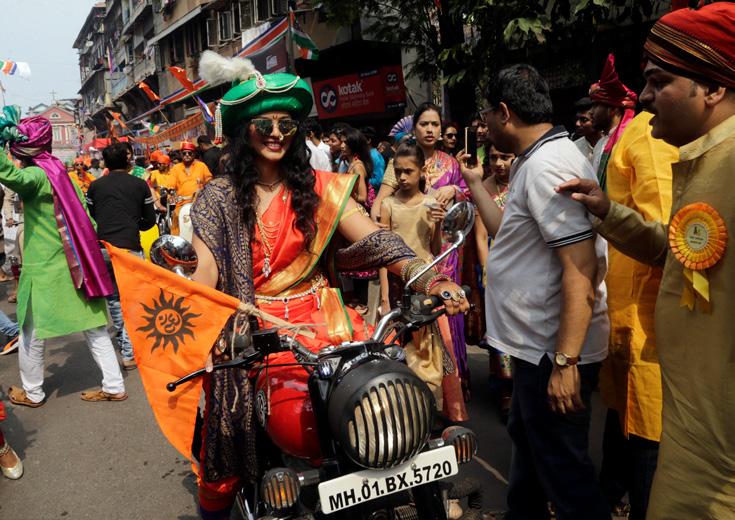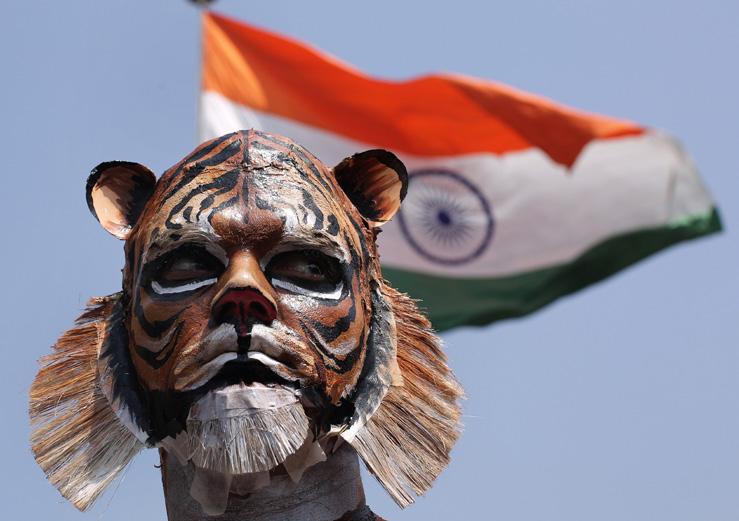
14 minute read
Hair for care
from 2018-03 Sydney (2)
by Indian Link
Sydney couple Parul and Varun Batra do their bit for cancer research . NEHA MALUDE reports

It was a cut with a cause. Sydney couple Parul and Varun Batra on 14 March took part in the World’s Greatest Shave (WGS) initiative to raise money for cancer research.

Having taken the brave decision to shave their heads, the couple has raised over $4,000, but is keen on raising at least $6,000 for the cause.
As you might know, volunteers get sponsored and the money they collect goes towards research for finding better treatments for leukaemias, lymphomas, myeloma and other related blood disorders. In Australia, a staggering 60,000 people are diagnosed with blood cancer and related disorders, the third most common cause of cancer death.
Varun tells Indian Link that his wife is the reason they finally took the plunge this year. “Parul has wanted to do this for sometime now, so this year we decided to go for it together. We thought the collective focus would increase support for the cause,” he says.
Going bald, especially for an Indian woman, is a big step. For most women, hair is more than just a part of their looks, it’s a part of their identity. Did Parul feel that she would lose a part of her identity or change her persona in a significant way?
“The only change,” Parul replied, “is that we feel a lot colder!” She added, “Did it feel strange? Of course. But to be honest, excitement was the over-riding sensation!”
The money they have managed to raise has boosted their confidence. “This has definitely motivated us to do more to make a difference. But the movement needs far more support. Parul and I are certainly going to try and find more ways to contribute to this event, not just in cash but in kind too,” Varun says.
Did they face any resistance or backlash from family? “Our families were a bit stunned at first, sure. But they came around, and when we told them why Parul and I were participating in this event, they were immensely proud of us,” Varun said. “Of course, Parul and I supported each other right from the beginning.”
In the past, Indian Link has reported on how two Sydney-based women, Deepa Hariharan and Vani Chandra, stepped up to the challenge and shaved their heads as part of WGS. While Deepa decided support the cause by raising $3,000 after a dear friend lost her life to brain cancer, Vani raised more than $5,000 for the Leukaemia Foundation by shaving her locks on her birthday.

This year marks 20 years since World’s Greatest Shave was started by the foundation in 1998.
What’s more, the foundation recycles ponytails into wigs and turns hair clippings into compost or floating booms to absorb oil spills at sea. Not only do you end up helping improve the life of a cancer patient, but also the environment. It’s a win-win all the way.
Check out https://worldsgreatestshave.com/ to know more.
How the money helps Volunteers earn badges depending on how much money they can raise.
Here’s what the badges mean:
Helping Hands Badge $250.
Enough to enable a family to attend a support program specific to their blood cancer.
Sleep Easy Badge $560. Enough to give a regional family a free place to stay close to treatment in the city for one week.
Beep Beep Badge $1200.
Enough to provide free transport for people who are too ill to drive after chemotherapy treatment, for two weeks.
Breakthrough Badge $2000.
Enough to aid future breakthroughs by funding a major blood cancer research project, for one week. Discover Badge $4800. Enough to fund 3 months of lab costs for a research project to discover better treatments for blood cancer.
Life Saver Badge $10,000.
Enough to provide emotional support to help 300 families overcome the initial shock and stress of being diagnosed.
Government confirms death of 39 Indians in Iraq
All 39 Indian construction workers kidnapped by the Islamic State in 2014 from Iraq’s city of Mosul have been killed, the government said on 20 March, confirming the worst fears after keeping alive hopes over their survival for the last nearly four years.
The confirmation came in the form of a suo motu statement External Affairs Minister Sushma Swaraj made in the Rajya Sabha after a limited truce was struck between the government and the opposition in the chamber of the House Chairman M. Venkaiah Naidu.
Sushma Swaraj, who had earlier made statements, including a 22 July 2017 answer in the Lok Sabha that “as per the latest information from multiple third party sources, they are all safe”, on Tuesday rejected the lone survivor Harjit Masih’s claim that the 39 Indians were shot dead as a “cock and bull story which wasn’t true.”
After questions were raised over the government’s confirmation, the minister held a press conference to say that the government cannot declare any person dead without concrete proof and it was her duty to inform Parliament first about their death rather than tell their families first.
“I refused to close the files (of the 39 Indians) till we had concrete proof in hand (about their death),” she said.
She informed the Rajya Sabha that Indian efforts to search for the missing led to a mound near Badush village in Mosul where a local resident said some bodies had been buried by the Islamic State under a mound.
She said deep penetration radars helped find 39 bodies buried under the mound. The bodies were exhumed and DNA samples from relatives of the missing workers were sent to Iraq.
The minister said DNA samples matched with 38 bodies and the 39th was yet to be fully confirmed because the DNA sample sent was from someone else in his family as his parents are dead.
“The first sign was that the bodies were exactly 39, plus strands of long hair and a ‘kada’ were also found. So we started conducting DNA tests.”
The victims - 27 from Punjab, four from Himachal Pradesh and six from Bihar and two from West Bengal - were construction workers employed by an Iraqi company in Mosul. The victims were taken hostage when the Islamic State took control of the second largest city in Iraq. They were trying to leave Mosul when they were abducted.
She said Minister of State for External Affairs VK Singh will go to Iraq to bring back the mortal remains of the Indians. “The plane carrying the bodies will first reach Amritsar, then Patna and then go to Kolkata.”
She dismissed the claims of Masih, the only survivor who escaped from Mosul. “He was not willing to tell me how he escaped,” she said.
He had escaped along with Bangladeshis with the help of a caterer with a fake name Ali, she said.
Briefing media persons later, Swaraj said her government did not believe in declaring a missing person as believed to be killed.
The lone Indian wondered why the government didn’t believe him all these years after having “spoken the truth”.
“I had been saying for the past three years that all 39 Indians had been killed by ISIS militants,” Masih, 28, a resident of a village in Gurdaspur district, told reporters.
He said they all were killed in front of his eyes.
Narrating the incident, Masih said the Indians were kidnapped by the militants and after some days they fired indiscriminately at them.
“I was fortunate to manage to escape from the clutches of the militants despite getting a bullet injury,” he said.
Reacting to the confirmation of deaths, Swaran Singh, whose kin was among the 39 dead, said Sushma Swaraj should have informed the aggrieved families about the deaths before “exploding the bomb on us” in Parliament.
ANJALI OJHA
China’s growing imprint through building of infrastructure projects in South Asian countries is proving to be “not so useful” for them and New Delhi is finding “cold comfort” in the fact that China’s aid was being relooked at by many of India’s neighbours, the government has told a parliamentary panel.
According to a report by the Parliamentary Committee on External Affairs, headed by Congress MP Shashi Tharoor, the panel was informed by the government that “experiences” with Chinese infrastructure projects in neighbouring countries like Bangladesh, Myanmar and Sri Lanka were leading these countries to give “at least some pause for thought.”

In “oral evidence” to the panel on February 16, Foreign Secretary Vijay Gokhale said that China had been a “net exporter of capital infrastructure technology in last five years.” China has said for many years that it did not intend to do this because it was very typically a Cold-War construct which the Americans had done, Gokhale pointed out.
“The logistics base at Djibouti is the first one where Chinese President Xi Jinping, wearing combat fatigues, addressed the soldiers in October, thereby removing even the veil of some ambiguity whether or not this is a military base,” Gokhale said.
He said China has begun a number of projects in every South Asian country with substantial commitments. “The experience has been that while initially the appearance of free money or cheap money as well as quick execution of projects - which we have to admit is very much a part of the Chinese modalities - was attractive to a number of these countries... there have been some experiences in some of our neighbouring countries which are now giving at least some pause for thought,” he said.
Giving examples, he said it was generally accepted that Sri Lanka’s Hambantota port, for instance, had proved to be an “economic burden” for the Sri Lankan government. “In case of Bangladesh, the general sense we got is that President Xi committed $23 billion when he went an official visit two years ago, but it now transpires that a large amount of this money is actually commercial credit and at interest rates which are comparable to international commercial interest rates, but they are also insisting on buying Chinese equipment rather than tendering on international basis,” he said.
Similarly, in Myanmar, there had been some rethinking on the Kyauk Pyu - a deep sea port which was to be a part of China’s One Belt One Road initiative - because the sheer size of the port did not appear to be something that the Myanmar government was going to utilise.
“That is the cold comfort to us,” he said, adding that the Indian government’s aim was to try to build infrastructure projects which were of interest of the countries in our neighbourhood.
“Our infrastructure projects are different from Chinese infrastructure projects in that they are largely demand-driven. In other words, we wait for governments of our neighbours to tell us what projects are required and then we proceed to do it,” he said, adding that prominent among these were India’s projects in Nepal, Bhutan and Bangladesh.
Gokhale also told the panel that India had raised concerns with China at the “highest level” about the proposed projects under the China Pakistan Economic Corridor (CPEC) in Pakistan-occupied Kashmir (PoK), and a constant vigil was being maintained.
During Xi’s visit to Pakistan in 2015, several bilateral cooperation agreements, including those on hydroelectric and nuclear projects, highways, motorways, ports, export processing zones, agriculture, and financial arrangements for projects were signed. Most of these agreements were for projects proposed under the CPEC, and some of the proposed projects were in PoK.
“Government’s consistent position is that Pakistan has been in illegal occupation of parts of the Indian state of Jammu and Kashmir since 1947. Government has conveyed to the Chinese side, including at the highest level, its concerns about their activities in PoK and asked them to cease these activities,” the report says.
“Government keeps a constant watch on all developments having a bearing on India’s security and takes all necessary measures to safeguard it,” the report quoted the foreign secretary as saying.
Hubris is letting down BJP
AMULYA GANGULI
If one explanation has to be given for the BJP’s electoral ills in the Hindi heartland and nearby states, it is arrogance.
Even more than the Narendra Modi government’s failures on the employment and agricultural fronts, it is the party’s and the government’s haughtiness, reflected in the Vice-president M Venkaiah Naidu’s characterisation of Modi as “God’s gift to the nation,” which has been undermining the party’s standing.
Ever since the BJP came to power, it has been dismissive of everything that happened in the past and vowed to start on a clean slate after eradicating 1,200 years of slavery under the Muslims and the British.
The reaction against the BJP’s hauteur was slow to take shape presumably because the people, especially youngsters, retained their faith in the Prime Minister’s Sabka Saath, Sabka Vikas or ‘development for all’ promise. It still works in states like Tripura which has seen little economic growth under prolonged communist rule.
But, elsewhere, the Modi magic has palpably started fading. The first sign was available in the Gujarat assembly elections where the BJP escaped defeat by a narrow margin. After that, the setbacks for the party in the Rajasthan and Madhya Pradesh by-elections substantiated the anti-BJP mood.
Now, the Uttar Pradesh by-polls have provided resounding confirmation of the slide in the party’s fortunes in mainland India.
For Chief Minister Yogi Adityanath to lose in his redoubt of Gorakhpur, where he is the head priest of the Gorakhnath temple, is far more indicative of the way the cookie is crumbling than the fall of the former chief minister Manik Sarkar’s government in Tripura, which was a cause of elation in saffron ranks.
For the BJP, the monk-politician’s electoral defeat is stunning for two reasons. One is that the elevation of this saffronrobed votary of “love jehad” and fake encounters to the Chief Minister’s post was intended by the Modi dispensation to show how much is changing in India as it marches towards a Hindu nation.
Adityanath’s ascent was meant to be a kick in the teeth for the “secular” camp which could not believe that a Hindutva hawk would be made the Chief Minister of India’s largest state.
The other reason why the BJP would be stupefied is that it will now have to shelve its decision to field Adityanath as the third main campaigner for the party after Modi and party president Amit Shah. Till now, the Chief Minister had been deputed to election-bound states to boast about the “developments” that were taking place in Uttar Pradesh.
Now, he will be an “unstarred” campaigner as a Congress minister in Karnataka has mockingly said. It is not unlikely that Adityanath will be derided on the next occasion when he addresses an election rally. His admission that overconfidence led to the BJP’s defeats in Gorakhpur and Phulpur is only partially correct, for it was not so much selfassurance which undercut the party but supercilious pride of being saviours of the nation from its “enemies”.
This scornful outlook towards its political adversaries was starkly evident in Bihar where Union minister Giriraj Singh warned voters that Araria will become a “hub of terrorism” if the Muslim candidate was elected. This crude display of communalism did not deter the voters.
The three or four “captive” television channels of the BJP have also been ringing alarm bells about the caste-based combination of the Samajwadi Party (SP) and the Bahujan Samaj Party (BSP), as well as the Rashtriya Janata Dal (RJD), bringing down the “nationalist” BJP in Uttar Pradesh and Bihar.
Even then, it is clear that the successes of these parties have sent out the message to the Congress and other opposition parties that the ground is ripe for unseating the BJP by a united front.
Till now, the BJP’s only hope of staying afloat was the disarray in opposition ranks. It may have also placed considerable faith in the machinations of cynical old-timers like Mulayam Singh Yadav to create fissures in the non-BJP ranks of the kind which enabled it to win big in Uttar Pradesh last year.
But times are changing. Young leaders like Akhilesh Yadav have shown that it is possible to overcome the earlier twodecade-old enmity between the SP and the BSP to bring the BJP to heel. The RJD has also demonstrated that its M-Y (MuslimYadav) base of support has remained intact despite Laloo Prasad Yadav’s incarceration. Besides, the Bihar outcome has shown that the latter’s son, Tajeshwi, has found his political feet.
There are now several relatively young leaders - Rahul Gandhi, Akhilesh Yadav, Tajeshwi, Jignesh Mewani - who are in the field. As Rahul Gandhi’s recent meeting with Sharad Pawar showed, they are now taking the initiative along with elders like Sonia Gandhi to bring the opposition parties together on a common platform. If they succeed, the BJP’s chances of repeating 2014 in the next general election are dim.
Indian GST system among most complex globally: World Bank
VISHAV
The Indian Goods and Services Tax (GST) system is among the most complex in the world with not only one of the highest tax rates but also one of the largest number of tax slabs, the World Bank has said.
It added that India has the highest standard GST rate in Asia, and second highest in the world after Chile.
“The tax rates in the Indian GST system are among the highest in the world. The highest GST rate in India, while only applying to a subset of goods and services traded, is 28 per cent, which is the second highest among a sample of 115 countries which have a GST (VAT) system and for which data is available,” the World Bank said in a report.
What makes the Indian GST system even more complex is the number of different GST rates applicable on different categories of goods and services.
India currently has four non-zero rates: 5, 12, 18 and 28 per cent. Apart from that, several items are taxed at zero per cent while gold is taxed at 3 per cent. To make things worse, petroleum products, power and real estate have been kept outside the GST ambit.

According to the World Bank’s biannual India Development Update report, most countries in the world have a single rate of GST: “49 countries use a single rate, 28 use two rates and only five countries including India use four rates,” it said.
Apart from India, the countries that use four or more GST rates are Italy, Luxembourg, Pakistan and Ghana.
While the government has said it would bring down the number of rates once the new taxation system stabilises, it has repeatedly ruled out a single GST rate.
“Luxury goods, sin products, and products hazardous to the environment and health can’t be taxed at the same rate as ‘common-man products’. Wheat, rice, sugar can’t be taxed at the same rate as a Mercedes car or a yacht or tobacco,” Finance Minister Arun Jaitley had said, while ruling out the possibility of a single GST rate.
When reached for comment, a World Bank spokesperson said that India is unique in terms of its size and scale of implementation when compared to other counties that have introduced GST. “The difference with other countries in design is therefore to be expected,” he said.
But it is not just the tax rates that distinguish India’s GST system from the rest of the world. According to the World Bank report, the fiscal threshold for businesses to fall under the full GST impact is also the highest among all comparable countries. In India, businesses having annual sales above a threshold of Rs 1.5 crore fall under the full GST, and are thus liable to remit GST and eligible to deduct input tax credit.
India started with a threshold of Rs 75 lakh, but in a span of a few months doubled it to Rs 1.5 crore, mainly to ease the cost of compliance of small and medium enterprises, the report said. “India’s new threshold is the highest among all the 31 comparator countries,” it added.
The report also took note of the disruptions in the initial days of the introduction of tax reform, but added the introduction of GST should be considered as the start of a process - not the end.
“There have been reports of increased administrative tax compliance burden on firms and a locking-up of working capital due to slow tax refund processing. High compliance costs are also arising because the prevalence of multiple tax rates implies a need to classify inputs and outputs based on the applicable tax rate.
“Along with the need to apply the correct rate, firms are required to match invoices between their outputs and inputs to be eligible for full input tax credit, which increases compliance costs further,” it said.
The World Bank spokesperson said the introduction of the GST is only the start of the process that government has undertaken to implement “this bold reform.”
“Drawing actively from user-feedback, the government has been very alert to implementation challenges and continues to take steps to make GST compliance more simple and efficient,” he added.
The World Bank said while international experience suggests that the adjustment process can affect economic activity for multiple months, “the benefits of the GST are likely to outweigh its costs in the long run”.
“Despite the initial hiccups, the introduction of GST is having a far-reaching impact on reducing tax-related barriers to trade barriers, which was one of the primary goals of the introduction,” it said. IANS







